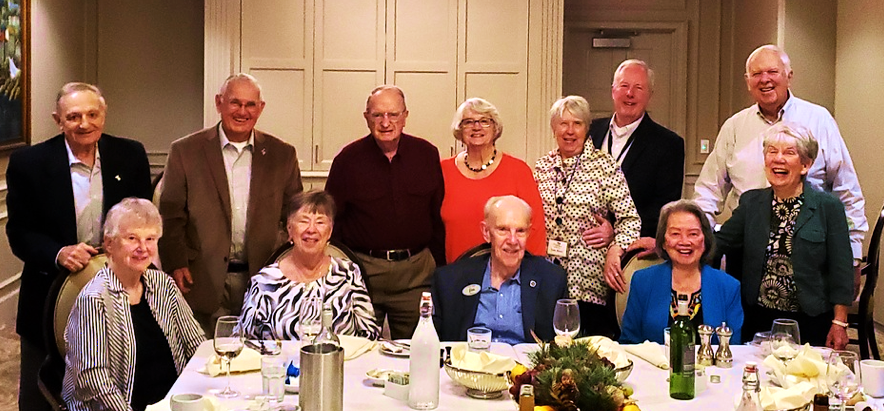
Written by Jim Bullington (Auburn ’58)
This curious concentration happened purely by chance, and the odds against it must have been extremely long. Yet six members of Sigma Pi Fraternity, from six different schools, who never knew each other previously, came together as fellow residents of Patriots Colony, a retirement community in Williamsburg, VA. They now get together regularly to socialize, along with their wives, both individually and as a group.
With 110,00 initiates since its founding in 1897, Sigma Pi is not among the largest college fraternities. Perhaps about 10,000 of the initiates would currently be retirees, with only a few hundred of them living in community retirement facilities.
Nor is Patriots Colony, with about 500 residents, a particularly large senior living facility, and there are well over 100,000 similar facilities in the United States from which the few hundred current Sigma Pi retirees considering such facilities could choose.
A statistician could make an informed guess about the probability of six Sigma Pi’s who never knew each other finding themselves in the same retirement facility. It must be vanishingly small.
The photo below shows the Patriot Colony Sigma Pi’s and their wives at a group dinner in the small dining room on January 26, 2024.
Couples left to right, with school and graduation year:
- Lynn and Sallie Moore Dievendorf – William & Mary, 1966
- John and Carolyn McHale – Drexel, 1962
- Tom and Ann Russell (standing) – St. Lawrence, 1955
- Jim and Tuy-Cam Bullington (seated) – Auburn, 1962
- Joe and June Kime – Ohio Northern, 1966
- Dave and Sue Lester – Franklin & Marshall, 1962
Tom Russell (St. Lawrence ’54)
I pledged Sigma Pi in the spring semester of my freshman year. We had a very small pledge class. I went back to the dormitory where I lived and convinced four friends to join me at Sigma Pi. We now had nine in our pledge class. The next semester (fall of 1954) I moved into the house. The dormitory where our beds were located was on the third floor.
The university is in Canton, NY, which is as far north as one can go without crossing the river into Canada. The first snow was usually in October. I remember waking one cold night with my bed covered with snow! After that, until spring, we found places to sleep down below. After my year living in the Sigma Pi house, I transferred to the U.S. Military Academy, a lot farther south in New York.
John McHale (Drexel ’58)
Starting in June 1957, the Navy had a co-op program with Drexel Institute of Technology for 30 incoming young men. I was one of the very deeply selected high school students who started working for the Navy as a civil servant at the Naval Air Development Center (NADC) in Warminster, PA.
I became a house freshman with Beta-Theta Chapter of Sigma Pi in September 1957. In the spring of 1958, I pledged and became a fraternity brother. For the next four years, I lived alternately at 210 North 34th Street for six months, then in a rooming house in Hatboro, PA, while working for the Navy at NADC. During my years with the fraternity, I had many responsibilities because we ran the fraternity house as a small business. Everyone had jobs such as waiting tables, washing dishes, plumbing, electrical wiring, painting, managing, etc. I also learned how to live in a changing environment with different social and military personalities including a wide range of ages and military aircraft. Eventually, in June 1962, I graduated from Drexel and became a full-time civil service employee at the NADC. The 29 other guys likewise had great careers.
There were ten fraternities at Drexel in 1957. Drexel is a commuter university and has a five-to-one men-to-women ratio. Many Sigma Pi guys dated women nurses from the seven nearby nursing schools. Along came September 1960 and Carolyn arrived at Drexel as a freshman. Now, the grass was not so green on the other side, and we started dating. By January 1961, we were an item. We were married in August 1963.
Sigma Pi had a Dalmatian dog named Domini, that had the run of the house. She guarded the house, allowing only people she knew to enter. The Philadelphia police patrolled the Drexel living area and Domini would allow any of them to enter the house for a cup of coffee. Her discerning factor was whether the policeman’s hat was on or off. She would growl and bark at the cop if he came onto the front porch wearing his hat!
Jim Bullington (Auburn ’58)
Sigma Pi has been part of my life since I became a pledge the week after arriving at Auburn as a 16-year-old freshman. It was a critical element in supporting my transition to college, and later in my campaign to become editor of the student newspaper.
In 1961, I wrote an editorial denouncing the mobs that attacked the “Freedom Riders” in Alabama and the political leaders who promoted this violence; condemning the racist culture in which those attacks were rooted; and calling for Auburn’s integration. The reaction began with a Ku Klux Klan cross-burning at the Sigma Pi house, where I lived, and continued with student mobs burning me in effigy, the university threatening my expulsion, and the governor menacing cuts in Auburn’s appropriation. Few of my Sigma Pi brothers agreed with my editorial, but most supported my freedom-of-the-press right to publish it, and I wasn’t disowned or censured by the fraternity. This editorial and the reaction to it were instrumental in my passing the Foreign Service exam.
As a career diplomat spending most of my working life in foreign countries, it was difficult to maintain ties with my Auburn brothers, but I’ve done so with a dozen of them, whom I count among my closest lifelong friends. I was delighted to find new Sigma Pi links at Patriots Colony.
Dave Lester (Franklin & Marshall ’61)
My roommate and I lived in the dorm at Franklin & Marshall during our first two years. The Resident Assistant down the hall was a Sigma Pi and quite a recruiter. Our pledge class included four or five guys from our hall alone. We both moved into the fraternity house as juniors, choosing new roommates at the same time. I bunked with three guys on the second floor, while he went up to the third floor with three others.
The new room was pretty special: one of the guys had his own phone line. No more waiting in line to use the phone booth downstairs. And we had our own bathroom, with two shower stalls. It didn’t take much convincing to agree to use one of those stalls as a shower, and the other to hide a refrigerator, which we bought for twenty bucks. I’ll leave it to you to figure out what we kept in it. The shower curtain kept prying eyes away. Another feature of our room was a back staircase down into the kitchen. We didn’t use it much, but it was a handy way for me to get to work — I worked as a waiter to defray my expenses.
I also served as house manager, in charge of heating, plumbing, and general maintenance. My brothers found ways to avoid small cleaning duties, which I assigned. In Lancaster, PA, it was the custom for everyone in town to wash their sidewalks every week. This was a twenty-minute task, usually done on Saturdays, but there was always a lot of griping about it.
Lynn Dievendorf (William & Mary ’63)
In the 1960s Sigma Pi and all fraternities at William & Mary were in one-story lodges (not houses) next to the football stadium. The lodge consisted of two bedrooms, two baths, a kitchen, and a large meeting/partying room. We expanded our party area by using the roof. The Drifters were one of our favorite music groups and our favorite song from their album “Under the Boardwalk “was “Up On the Roof.” We spent many a weekend sunning and dancing on that Sigma Pi lodge roof. Luckily over the years, no one fell off despite all the partying and dancing,
Joe Kime (Ohio Northern ’62)
I went to Ohio Northern University in Ada, Ohio. It was a small Methodist university; when I started there were about 1800 students, with eight fraternities and three sororities. I pledged Sigma Pi in my freshman year. The fraternity had a small house in a neighborhood off campus and I lived in housing away from the fraternity. As the university grew, we had an opportunity to build a new chapter house. This house was able to accommodate most of the chapter members. It was a great experience to be part of this project and then live in the new house. Since the school itself was small, we interacted with all the Greek organizations which, along with the classes, was an essential part of the education process. The best part of being a Sigma Pi is meeting alumni as time goes by, highlighted by being at the Patriots Colony and meeting the five other brothers living here.

 Resources
Resources
